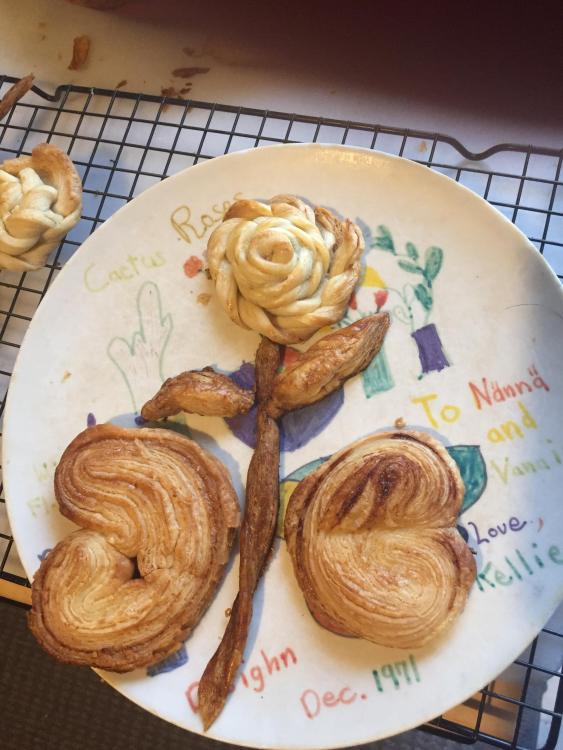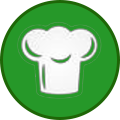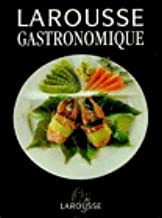-
Posts
891 -
Joined
-
Last visited
Content Type
Profiles
Forums
Store
Help Articles
Everything posted by paul o' vendange
-

Your Daily Sweets: What Are You Making and Baking? (2017 – )
paul o' vendange replied to a topic in Pastry & Baking
That’s so cool it’s in her book. Been a long time since I’ve visited Julia, about time I say hello again. (« Julie and Julia » doesn’t count, I know!). No false modesty here, Heidi, but you and so many here are the inspirations. I’m really grateful all you all have done to keep this community thriving. -

Your Daily Sweets: What Are You Making and Baking? (2017 – )
paul o' vendange replied to a topic in Pastry & Baking
Same dough day later, some palmiers. I’m hoping this isn’t just a one off, but even after an additional turn this morning (to coat dough in sugar before final rollout), and using 100% bread flour (11.7% protein), this dough was a real pleasure to work with. Now, of course, there is that $10K yearly Beurre d’Isigny or Echire budget I have to work out with the family.🥳 -

Your Daily Sweets: What Are You Making and Baking? (2017 – )
paul o' vendange replied to a topic in Pastry & Baking
Very cool. Never made them but quick look sure looks like them! -

Your Daily Sweets: What Are You Making and Baking? (2017 – )
paul o' vendange replied to a topic in Pastry & Baking
Thanks Heidi. The filling is really nothing more than a pastry cream with a microplane zest of a whole lemon. The starch is 100% cornstarch, which is interesting to me. Way too rubbery on it’s own, I think it works great as a filling here. -

Your Daily Sweets: What Are You Making and Baking? (2017 – )
paul o' vendange replied to a topic in Pastry & Baking
I’ve actually never made inverse puff pastry before. Idea from the Ferrandi Patisserie book using lemon crème bichon, with inverse puff from Chef Lindsey Farr. Have to say, it’s been a long time, but from memory, this method beats out traditional puff for me. Eager to play with the stuff. Calling them “clamshell lemon turnovers.” -

Bread books for beginners recommendations.
paul o' vendange replied to a topic in Cookbooks & References
Um, baker’s 10?😆 That would be 37% WW. I think. Give me a second, I only have a dozen fingers to count on. -

Bread books for beginners recommendations.
paul o' vendange replied to a topic in Cookbooks & References
I go with Central Milling, usually their organic line, for my white flour and whole wheat in fine and medium. I originally tried their « Beehive, » which comes in at 10.7% protein. Great baguettes and levain, as long as hydration isn’t high on either. My base from them is their Baker’s choice Plus, clocking in at 11.7%. Performs beautifully. Interesting ng the whole wheat they sell is listed as « Hi-Pro,” in three milling grades. They tout a gentle milling process that significantly lessens shearing. I’ve made 100% WW Hi-Pro (fine) with spring and openness approaching straight white flour levains. My go-to is my best emulation of a traditional French pain au levain, with 63% Baker’s Choice and 27% Hi-Pro fine. I like it a lot. -
Oh god, I didn’t about Floyd and Aaron. Fatima’s passing ripped a hole...like you I was smittened by her a great deal. Seeing her so ill and reading some of her final words, knowing she and Padma had become good friends through to her death was all so bittersweet, stings every time to see such a beautiful life gone. In a different way, a hole opens up every time we see Tony Bourdain. God we miss him too, and still don’t fully get it that he’s gone. Such a force of wild nature, who closed the world’s strangeness to itself. Peace to their memories.
-
Watching season 3 as we write. Tre, a strong fave of mine, eliminated last night. My my wife actually worked with Dale at a Chicago spot. He was bartending in a sort of breather. He’d been on the show by then, but couldn’t talk. Trippy to see him on the show.
-
That’s good to hear. I didn’t agree with the ultimate call, but he’s clearly a gifted chef. King Georges is a fantastic look at the two of them, you’ve probably seen it. Edit: Ripert, sorry. I’d read in some sources that they’d had a falling out as a result of her losing it on elimination. I regret mentioning it as a bit gossipy. I see they’ve been together in interviews and events since.
-
Oh god, impossible, lol! A lot of them I’m so fond of some of the chefs and so I get bummed when they get eliminated. I also get pissed when one of my faves loses to the wrong chef (imo, of course 😁. Seasons 2 and 11...). Season 11, Nick winning didn’t sit at all well. Soft spot for Stephanie, Nina too. Sad thing is, Nick was chef de cuisine for Georges Perrier at Le Bec-Fin, before it closed. Which brings up a point. I’m so often blown away by the pedigree many of these chefs have, only to cook so poorly on the show. Or tanks a relationship with mentors, e.g. season 8, J’en and Eric Ripert. Yikes! )
-
Good. Been through each season multiple times and still, on completing, I get deeply bummed. Oh, and: 1. Padma called my bread “beautiful” once, in a tweet. 2. I exchanged with Tom a bit, on the epochal topic of Gilroy garlic. My life is complete.
-
I have a few by Chef Ducasse - Flavors of France, his first book (Riviera), Atelier, his bistro book, maybe a couple I am forgetting. Let me say at the outset I prefer books that are written with as little adjustment to home limitations as possible. I want to learn the chef’s techniques, equipment and materials, but above all else, I want to try and capture the chef’s mind, see the inner life and how it expresses in her or his cuisine, and that things not be “simplified” or “adapted” for the home kitchen. To that end, on Ducasse, I have long looked at his massive bibles, beginning with his first, the Grande Livre de Cuisine, followed by Desserts and finally on Mediterranean cooking. On the other hand, as they are bloody expensive, I’m loathe to take the plunge if they are basically reference entries, no real techniques, reasoning and/or genesis behind a given recipe, and/or recipes themselves. In a word, ignoring the fact a cuisine stuffed with black and white truffles (especially, as is his wont it seems, the latter), foie, and caviar isn’t something I’ll be working but on rare occasions (like, “My Last Supper” rare, lol), is the book useful as a working and teaching text, from the professional kitchen point of view?
-
Terrible sucker for sensory allurement. Chocolat?, emergency outing to store for movie fix of crappy chocolate. Babette’s Feast? Off to the races and little sleep. The Cook, the Thief, his Wife, and her Lover? Don’t ask. Reading through « My Last Supper » (apologies - iPhone stuck on French, no idea why), pg. 126, Martin Picard in a late fall woods. Before my body went on permanent strike, used to be my favorite place to be alone, or stalking deer in vast wilderness tracts with my son. He references a recipe for snipe from the 1984 edition. And I am screwed yet again as I must have it. I prefer to read in French, both to keep alive in the language and because I overwhelmingly prefer to read stuff in its original language (leaving my options to a good French, a middling Spanish and a laughably bad German). I couldn’t find a purely French 1984 (Edited by Robert Courtine). I do see a French-English version, but don’t know if it is faithful to the original. Anyone have it know anything about the bilingual edition? In their contents, are they identical? French-English:
-
1961 in my eager hands!
-
I used to get whole moulard in wholesale from Christian Gasset of Au Bon Canard but that was a long time ago and he is more than busy supplying chefs around the country. I really like Muscovy but love moulard. I’m coming up empty on whole moulard. Anyone have any source?
-
Swan, I’d forgotten! That should be a helluva bbq. Hon, can you pass that giant bird with flames shooting out it’s nostrils? Oh, and the lard pie, with live doves - too much? 😆 You have me thinking (you all do, actually), I should be going backwards in editions, not forwards. In all seriousness, thank you @FlashJack, it’s a perfect idea.
-
Very interested as well, sounds delicious. Viognier can be such an imp, but the right marriage is wonderful. Funk note is interesting. Love it in farmhouse ciders (Normandy), saison and touches in certain British ales done traditionally and on cask. Can’t say I’ve picked it up in a wine, and it’s presence especially in a viognier would be great interesting. Thanks, @weinoo. @JoNorvelleWalker, very cool. Brewer very interested in traditional methods (British ales). My wife is Estonian and she loves their version of sahtis, runoff in spruce boughs and very open to “good” infections during fermentation. Before Covid, for an anthropology course my son was taking, I helped him put together a best guess on late kingdom Egyptian beer. Mash “brick” is fermented on mash in a clay pot, as well. Would be interesting to follow the thread on the process you describe. So - mad for French (Pinot) burgundies, always on the hunt for the rare price break at better appellations, or solid wines at village or regional cru. Always up for new or undiscovered Willamette Valley as well. Back in 2005 my wife won the national fellowship to attend IPNC - nice. Ample time with Martine Saulnier, Riedel, tons of extraordinary makers, tons of great wine. I ran our restaurant. I’ve never gotten over the jealousy.😂 So if anyone has ideas....🥳
-
Fascinating. Is oxidation induced late fermentation, or in the bottle? Any sherry or Madeira qualities?
-
I know of their slicers but not this knife - flexible, wider blade fillet knife, at Williams for $100. Anyone have any experience?
-
No specific recommendations, though drooling, but there’s a pretty wonderful book, Great Kitchens: At Home with America’s Top Chefs. Open discussions of noted chefs and their home kitchens with excellent photos and a floor plan for each. The opening chapter is Ken Hom, who at the time of publication maintained homes in Berkeley and Catus, Southern France. Beautiful. The ubiquitous commercial range, island stuffed with tools (he likes to look at them as beautiful unto themselves); wokburner and, interestingly, a commercial Hobart DW (he teaches at his home). Couple dozen homes of chefs and chefs/partners. For me, deepest possible sinks (with overhead stockpot - faucet at the range), commercial 6 burner range, wood fireplace/grill/split (see Jean-Pierre Moulle (sic - no special characters), formerly of Chez Panisse; Mark Miller), brick bread/pizza/roast oven (Alice Waters), extensive kitchen herb and veggie garden (Alice Waters!), open plan kitchen/DR/LR (See John Folse - add in vaulted timber frame, “theater” kitchen!). Ton there. I either drool or cry into my glass. GoFund Me for that beautiful little farmhouse off the Côte D’Or because I’m just a swell, swell guy, pending).
-
Thanks weinoo, will do on the Beard book. I’d seen it referred to in Jeremiah Tower’s autobio (I think), but for some reason I’d thought he was an Eastern guy. Many thanks!
-
I’d say all three, though of them, recipes least. A lot of time spent going down a rabbit hole of references to references to ...:: - and a lot of times, inspired, usually in pulling together a menu (home - family and friends, long out of the industry and it literally feels like I’ve forgotten everything I’ve ever known - another story). My heart is in classic French (go to Carême for a kind of comfort in nesting historically, Escoffier dependably), and here the book makes me smile. That said, I’m terribly addicted to books. I prefer great chefs, with little accommodation to home cooking. I want to see inside their mind as directly as possible, and adapt as I can. Not Larousse specifically, but one huge lament: I grew up on the Pacific Ocean coast, surfing, fishing and diving. I now am chained to the MW and try to explain to my family how much it bums me out to buy seafood here. Sea- and fertile-coast/veg-centric (long) seasonal cuisine - e.g. David Kinch and Manresa, French Mediterranean or Brittany - can’t afford to buy Browne Trading regularly and can’t bring my myself to buy what they proffer here in whole fish - bronzini, striped bass, red snapper; forget trout, all shellfish. It’s lucky I was a probably born with a Burgundian heart, love fowl, all game, lamb. But man I miss the produce, and same hour, much less day, much less however many days since our poor specimens swam alive, of all seafood. Man, rant more than a lament, I guess! To bring it back to Larousse, my heart is pretty classically French and the edition I have is beautiful in this way (like yours, I imagine). Brief notes on this latest edition talks of some new techniques, good product coverage, a more global approach, and some looks inside some great kitchens and their approach (ALWAYS a sucker for the latter). So, got a bug for some of it, just not sure it’s a $65 bug when I already have a bible I love. Weight - Advil, 😆. Reps with Larousse, CIA, Kamman, Ferrandi. Who needs a gym? (Do not gush about Ducasse’s massive encyclopedias. I may get in shape, but my wife will kill me.).💪😳
-
Just hoping to get a comparative sense of the latest (?) 2009 edition, black and white cover, and the 2001 “revised and updated” edition, red cover? I have the 2001 and am very devoted to it but trying to get a sense if it’s worthwhile getting the 2009 edition. Any thoughts? thanks.
-
I don’t disagree. Bernie’s right and we are talking thermal conductivity in addition to thermal mass. It’s nigh just impossible to replicate the bake from a brick pizza and and home, no matter what we do. So we do what we can. I’ve found steel is just not very good compared to my results obtained using either a stone and an array of saturated linen, or a cast iron cloche as advocated by the Tartine approach. I should note I’m talking about levain only, not pastries. if folks haven’t read it but are interested, the late Alan Scott was a guru behind a resurgent interest in traditional brick ovens. See The Bread Builders. Mud ovens, too, are pretty wonderful. There’s some cultural anthro study out there re the traditional mud ovens of Quebec, 16th century on. Forget it’s name, but it’s somewhere and fascinating. At any rate, this is pretty far off Anova, apologies. Just wanted to share my experience. Will beg off now.









